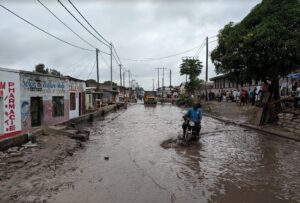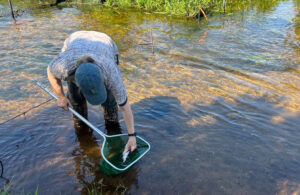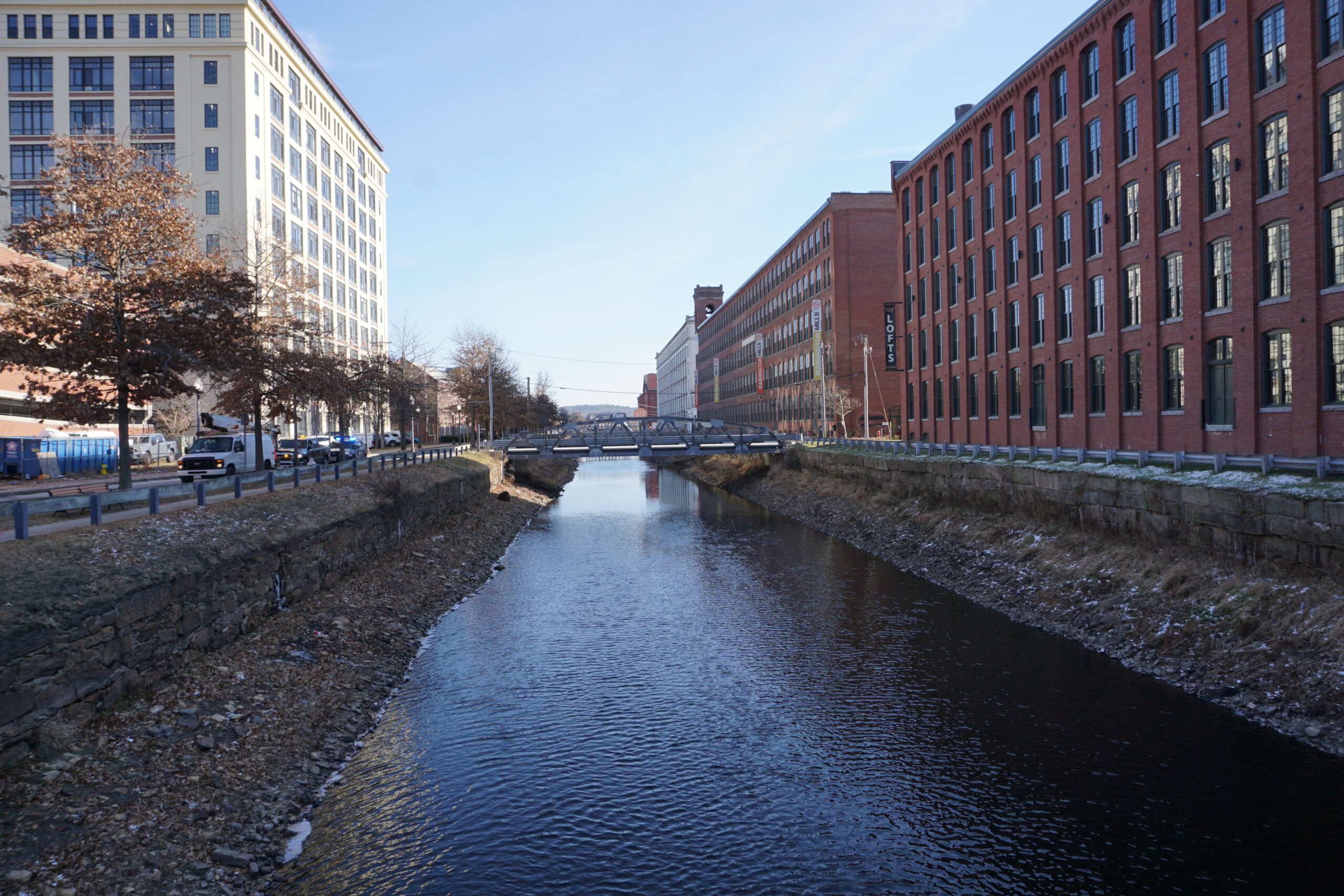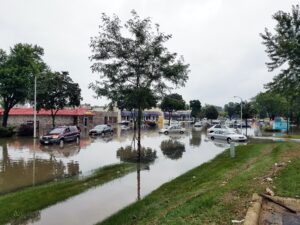Record rain is hitting drought-stricken areas. That’s not good news.
A warmer climate is driving precipitation to higher extremes in both flooding and drought

Extreme ‘whiplash’ between drought and floods makes it harder to recover from climate disasters

Parts of northern Texas, mired in a drought labeled as extreme and exceptional, are flooding under torrential rain. In a drought.
Sound familiar? It should. The Dallas region is just the latest drought-suffering-but-flooded locale during a summer of extreme weather whiplash, likely goosed by human-caused climate change, scientists say. Parts of the world are lurching from drought to deluge.
Rebuilding Massachusetts’ wetlands from the ground up
Four years into a transformative restoration, the Coonamessett River is a living laboratory for how to revive an ecosystem

Dr. Christopher Neill, a senior scientist at Woodwell Climate Research Center, holds a confused snapping turtle at an arm’s length, doing his best to keep the snapping end as far from him as possible. He moves it off the walking path to a sandy hill. Another turtle has already found a comfortable spot nearby and begun laying eggs.
“I guess with this lightly vegetated area, we’ve made great snapping turtle nesting habitat,” Dr. Neil says, wiping off his hands.
The slope overlooks the older section of the Coonamessett River restoration project— a chaotic and vibrant wetland dotted with rushes, sedges, and shrubs. Swallows and osprey wheel overhead, the larger birds plunging down to the water occasionally when they spot a meal.
Two decades ago, this area was a cranberry bog. Cranberry plants grow well with their feet wet and many of the river valley’s natural wetlands were converted for their cultivation. Native biodiversity was plowed under and flooded, and the original course of the river was diverted for better control of irrigation.
When the cranberry growing lease on the land ended in the early 2000s, a determined group of local residents, who would come to call themselves the Coonamessett River Trust, pushed the town of Falmouth, Massachusetts to return the land to its natural state—a diverse natural wetland. Despite some opposition, the proposal was successful and work began on the restoration in 2017.
When the wetland was converted, it took with it ecosystem services it had been performing in the watershed for millenia. Wetlands are good at removing nitrogen. When groundwater interacts with plants and microbes, polluting nitrate is converted into plant biomass and harmless nitrogen gas. Here on Cape Cod, nitrates that leach out from homes and yards in fertilizers and wastewater typically get a free ride to the coast, causing algal growth to explode in estuaries. When these blooms die and decay, they use up oxygen in the water which can suffocate fish.
Additionally, many of the wetlands converted to cranberry bogs were originally Atlantic white cedar swamps, a unique ecosystem abundant in Sphagnum moss. This genus of moss forms peat as it dies and builds up in the soil. Over time, peat soils can sequester massive amounts of carbon.
The goal of restoration is to reinstate these natural processes. But getting an ecosystem back to a self-sustaining state can require a little tinkering—making adjustments to the landscape and water flow to encourage the flourishing of some species over others.
There can be trade-offs between sequestering carbon and building biodiversity, though. Compared to grasses, trees offer more long-term carbon sequestration, but the shade they provide limits the number of species that can grow underneath them. A mosaic of open, grassy, meadow combined with more wooded spots allows for greater diversity. While the first section of the Coonamessett River restoration prioritized tree growth, project scientists designed the second phase with more intentionally varied topography for diversity— some higher, drier patches where trees can thrive, and some lower, boggier areas preventing tree saplings from out-competing the grass.
Researchers now come to the site frequently to continue monitoring how the wetland is changing over time— conducting water sampling, measuring river flow, and surveying biodiversity.
“I think we’ve shown that the naturalization process can work extremely well,” says Dr. Neill.
Counting on Herring
Another crucial element of a successful restoration is keystone species—creatures that have an outsized impact on the overall ecosystem. In the Coonamessett, that means the alewives and blueback herrring (collectively called river herring) that used to overwhelm these waterways. They are a fish that, as Woodwell senior scientist Dr. Linda Deegan says with a grin “participates heavily in the food chain. Unfortunately for them, near the bottom.”
Because almost everything eats them, a healthy river isn’t possible without them. Though they spend much of the year out at sea getting snacked on by tuna, cod, striped bass, and whales, they make the journey each spring up rivers like the Coonamessett to spawn and offer another dining option for osprey, herons, and freshwater fish species.
Populations of river herring have suffered both from overfishing on the open ocean and degradation of freshwater habitat. Before the restoration, low bridges, culverts and water control structures for growing cranberries and the altered channel of the Coonamessett River and prevented herring from easily traveling up river far enough to spawn. Both species of river herring were under consideration for the endangered species list, though they were never listed.
Herring populations have stayed steady recently, in part thanks in part to efforts like the Coonamessett restoration. Now, Dr. Deegan leads herring tagging efforts on the Coonamesset—one of the longest herring tagging operations in the northeast—to keep a close eye on fluctuating populations.
A researcher, usually Dr. Deegan herself, will catch the herring as it swims upriver to spawn, anesthetize them, and insert a tiny tag into their flank before sending them back on their way unharmed.
“When the fish passes through one of our antennae set up along the river, the antenna charges the tag and uses that to send a signal that registers the information in our data logger,” Dr. Deegan says. From this information we know what sections the herring have trouble migrating through, indicating the priority areas for restoration.
Volunteers also conduct fish counts as the herring make their way upriver between April and June each year. The hope is that, as the restoration grows in, it will ease the fish’s path to their spawning grounds and put them back on track towards the levels of abundance seen in the early 1900s. That abundance will in turn support species higher on the food chain.
The restoration’s successes have already garnered interest from across the community. Dr. Deegan leads elementary school groups through the process of tagging fish. Some older grades will later incorporate the data into their lesson plans, “adopting” tagged herring and following their journey through the river.
The adoption program and school visits have helped students recognize their shared responsibility for the health of the River. Dr. Deegan recalls a recent encounter with one 8th grader who returned to visit the restoration project. His 2nd-grade class had adopted herring and he was examining the river to see if more fish were coming back now. He makes the trip over on his bike frequently to keep tabs on the herring. The restoration has created a multi-use space that encourages recreation and education in addition to conservation science.
From Mudflat to Wetland in Under Two Years
Dr. Neill moves upriver to the footbridge where volunteers count herring in the spring. It overlooks the second phase of the restoration, completed in early 2020. Fewer trees have established themselves here, but it thrums with the diverse sounds of living things—from rustling grasses, to twittering birds and whining insects.
“This was a mudflat in the spring of 2020,” says Dr. Neill. “It ended up green and naturalized in two years.”
Though the effort of the restoration team created the right conditions for the land to flourish, much of the project’s success comes down to the sheer resilience of nature. For Dr. Neill, it’s a powerful proof of concept, especially when he thinks back to the objections raised at the outset of the project. Skeptics had doubted whether a restoration on this scale could be accomplished without falling prey to opportunistic invasive species like Phragmites—a common reed that can crowd out native plants.
“Nobody thought this would be nearly this successful. Now look at this. It’s got all this native vegetation, native grasses, blue flag Iris, sedges, rushes, and cattails. Very little Phragmites anywhere. Almost everything came in naturally, from what survived under the cranberry bog.”
The wetland that had persisted for thousands of years before the cranberry farmers, was still in the landscape. Buried deep in the soils, old seeds, dormant for at least a century, waited patiently. One quick turn of the soil during the restoration effort brought them up to the surface, and they needed no convincing to reclaim their place on the land again.
Climate risk Assessment: Lawrence, Massachusetts

Introduction
The impacts of climate change on the frequency and severity of physical hazards are putting many communities at risk. As the threat of climate change grows, so too does the need for accessible information, tools, and expertise to support climate-resilient decision making for municipalities. Woodwell Climate Research Center (“Woodwell”) believes there is a need to localize and customize climate risk assessments. This information is critical for local government leaders as they make planning decisions, but it is not available to all communities. Woodwell believes that this science should be freely and widely available. To address this gap, Woodwell works with communities across the world, including Lawrence, MA, to provide municipal climate assessments, free of charge.
Results summary
As a result of climate change, temperatures are projected to increase in Lawrence, Massachusetts. The probability of the 100-year rainfall event, a useful indicator of flood risk, will likely triple by the mid 21st century and more than quadruple by the end of the century. In addition to periods of extreme rainfall, the city can expect the frequency of drought to increase. Negative impacts associated with these climate hazards will be disproportionately felt by elderly, poor, and minority populations. Groundwork Lawrence (groundworklawrence.org) has been actively engaged with the community in efforts to address these imbalances. Here we present our findings on extreme precipitation, flooding, drought, and heat to help Lawrence in its plans to create a more resilient future for all residents.
Extreme precipitation and flooding
The trend of intensification of extreme precipitation in the Northeast US is expected to continue under future warming. Intensification here speaks to both more frequency and more severe rainfall events. Here we use localized future precipitation data from a regional climate model1 to calculate the change in probability of extreme rainfall events. In Figures 1 and 2 we show the changes in the return period of the historical (2000–2020) 100-year rainfall event for 2040–2060 and 2070–2090, respectively. By 2040–2060, the historical 100-year event will occur with a return period between 1-in-20 and 1-in-50 in the Merrimack River valley and approximately 1-in-30 in Lawrence, MA. By 2070–2090, the 100-year event will become a 1-in-15 year event for the region.
According to the National Atlas 14 published by the National Oceanic and Atmospheric Administration, the 100-year rainfall amount in Lawrence, MA is 7.85 inches. By 2040-2060, the 100-year amount increases to 10.97 inches and by 2070-2090 this further rises to 13.3 inches. The increase in rainfall translates to larger streamflows and increased flood extents as shown in Figure 3. The historical floodplain2, based on 20th and early 21st century rainfall and streamflow data, covers large portions of downtown Lawrence, especially on the southern bank of the Merrimack river because the location is the point of confluence with the Shawsheen river. The commercial and municipal district, including the courthouse and Lawrence General Hospital on the north bank of the Merrimack river, are also susceptible to flood impacts due to the convergence of the Spicket and Merrimack rivers at the eastern edge of the Lawrence city limits. The historical floodplain impacts 1,952 structures within the Lawrence city limits. By 2040–2060, the number of structures increases to 2,688 and by 2070-2090 the figure further increases to 3,093. The stormwater system was not included in the flood modeling effort because data was not available from the City of Lawrence; however, it is highly likely that the efficacy of the stormwater system would be compromised during periods of extreme water levels on the Merrimack, Spicket, and Shawsheen rivers as outfalls may be temporarily submerged. Additionally, according to the City of Lawrence Stormwater Management Program Plan3 dated June 2021, there is no stormwater infrastructure located in southern Lawrence between MA-28 and Andover Street which becomes heavily inundated during the 100-year rainfall event.
Can farmers fight climate change? New U.S. law gives them billions to try
Cutting emissions from fertilizer and livestock will be key, scientists say

Tanguro Ranch, Brazil 2018
When settlers plowed the North American prairie, they uncovered some of the most fertile soil in the world. But tilling those deep-rooted grasslands released massive amounts of underground carbon into the atmosphere. More greenhouse gases wafted into the skies when wetlands were drained and forests cleared for fields. Land conversion continues today, and synthetic fertilizer, diesel-hungry farm machinery, and methane-belching livestock add to the climate effects; all told, farming generates 10% of climate-affecting emissions from the United States each year. Now, Congress would like to turn back the clock and return some of that carbon to the soil.
Woodwell Climate Research Center has worked for years to understand and highlight the scale of the global climate crisis and has called upon policymakers to act with urgency in addressing this threat. The Inflation Reduction Act (IRA) is historically significant legislation, providing incentives and policy tools to dramatically reduce U.S. greenhouse gas emissions and put the United States within reach of its nationally determined contribution (NDC) for climate action.
A robust analysis by Princeton University’s ZERO Lab estimates the impact of IRA projects on greenhouse gas emissions to be a reduction to 40 percent below 2005 levels, by 2030. The U.S. NDC sets a target of 50 percent reduction below 2005 levels. With additional action from the private sector and state and local governments, the United States has a realistic chance to meet its current climate targets and set a path toward a safe and stable climate.
Of course, this legislation is not perfect. In particular, there are fossil fuel provisions in the bill that seem antithetical to climate action. But the net result of this legislation is overwhelmingly positive for the climate, and is the most substantial step forward for climate policy in U.S. history.
Numerous sections of the bill touch on areas of specific Woodwell expertise. Natural climate solutions are essential for meeting both U.S. and global emissions targets, and Woodwell scientists have focused much of their research on the most effective strategies to maximize carbon storage in forests and soils. The IRA invests heavily in natural climate solutions.
FORESTRY
The Inflation Reduction Act addresses the fact that climate change can accelerate wildfires, and also the importance of trees and forests for carbon sequestration and climate change mitigation. Among other forestry provisions:
- The Act includes $2.15 billion for National Forest System land restoration and fuel reduction, with a particular focus on “the wildland-urban interface.” Fires in these areas present the most significant danger to human health and safety.
- This $2.15 billion includes $50 million “for the protection of old growth forests on National Forest System land and to complete an inventory of old-growth forests and mature forests within the National Forest System.” Woodwell research has shown that old growth forests are critically important for carbon sequestration.
- The Act also includes $550 million for grant programs dedicated to non-federal forest landowners. This includes:
- $150 million for a grant program that will support “a cost share to carry out climate mitigation or forest resilience practices in the case of underserved forest landowners.”
- $250 million for grants that will help underserved forest landowners or landowners of forest lots less than 2,500 acres participate in emerging carbon markets.
- $1.5 billion over nine years for grants that will drive urban and community forestry projects and $700 million for the Forest Legacy Program.
AGRICULTURE
The Inflation Reduction Act provides significant incentives for improved agricultural techniques that would, among other benefits, increase soil carbon sequestration. Existing federal agricultural conservation programs, for example, are heavily oversubscribed, and the Act provides additional funds to help farmers and ranchers implement and expand practices that would reduce greenhouse gas emissions. Woodwell scientists have been among the leaders in researching the potential of soil carbon as a climate change mitigation tool, and the processes for measuring, monitoring, and validating increased sequestration. Among other conservation and agricultural provisions, the Act includes:
- More than $20 billion in overall funding to help farmers mitigate climate change, including significant funding for “agricultural conservation practices” that “directly improve soil carbon, reduce nitrogen losses, or reduce, capture, avoid, or sequester carbon dioxide, methane, or nitrous oxide emissions, associated with agricultural production.”
- $1.3 billion for the Natural Resources Conservation Service to provide technical assistance and collect field-based data on greenhouse gas emissions associated with agricultural practices.
RISK
The Inflation Reduction Act recognizes the current and increasing physical hazards presented by climate change, and the fact that many communities are not prepared for climate change impacts. Woodwell works with local governments around the world to provide granular climate services, free of charge. There remains, however, an enormous need to expand this science and to provide funding to support adaptation measures.
- The Inflation Reduction Act provides $3 billion in Environmental and Climate Justice Block Grants. Among the eligible uses of this funding are “mitigating climate and health risk from urban heat islands, extreme heat, wood heater emissions, and wildfire events,” as well as general “climate resiliency and adaptation.”
- The bill includes $4 billion to increase drought resilience in the Western United States.
As Boston heat records fall, scientists see climate change’s fingerprints

Point to a string of 90-plus-degree days in Boston and call it climate change, and someone might tell you: There have always been hot days.
And it’s true. The historical records are full of occasional blips when temperatures soared.
But the relentless heat of this summer — the heavy curtain that has hung over Boston, making the air thick and the going slow — is different, and has been made more likely to happen thanks to climate change, according to scientists. And while these seemingly endless strings of scorching temperatures feel terrible, these experts say they are just a taste of what’s to come.
Continue reading on The Boston Globe.
Jet stream stokes both deadly Midwest flooding and Northwest heat

Deadly floods are slamming the US Heartland. More than 2,000 miles away, dangerous heat is scorching the Pacific Northwest. The same phenomenon is to blame for both.
A massive bend in the jet stream — narrow bands of high winds encircling the Earth — is causing the havoc. In the Northwest, the jet steam has curved far north, allowing hot air to surge into Oregon and Washington. In the Midwest and Appalachia, it’s dipped south, bringing cool from Canada that’s colliding with with tropical air from the Gulf of Mexico, triggering ruinous downpours in Missouri and Kentucky.



